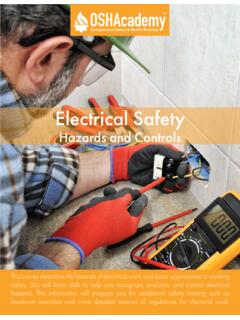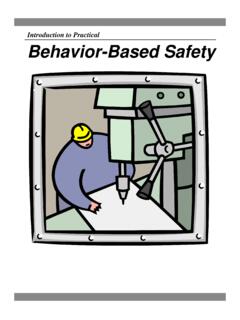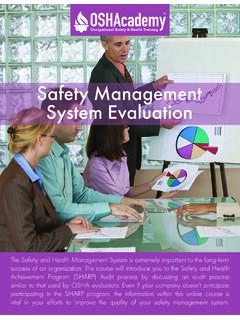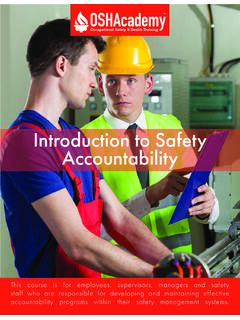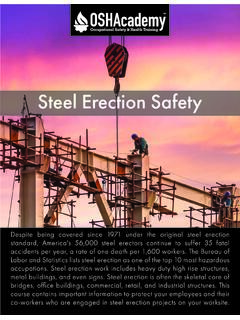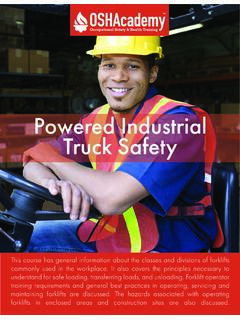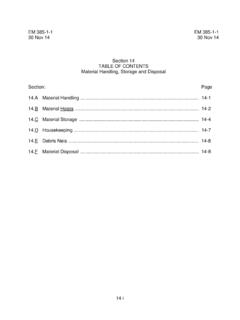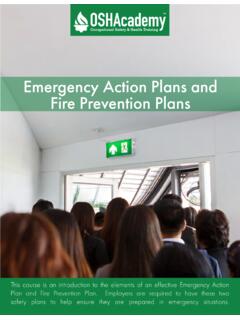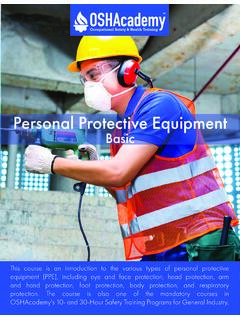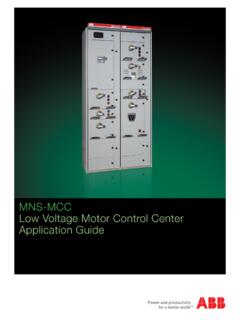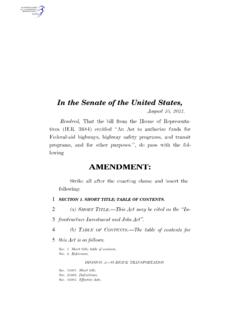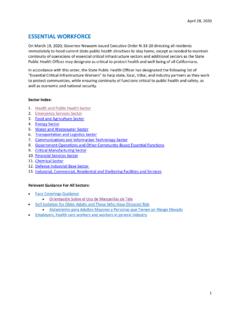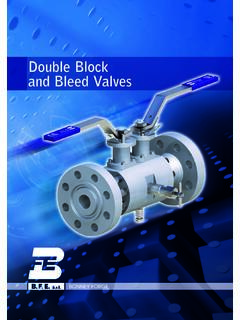Transcription of 158 Crane Safety: Basic - OSHAcademy
1 Crane Safety BasicThis course is intended as a Basic introduction to OSHA's standard 29 CFR 1926 Subpart CC Cranes & Derricks in Construction. Emphasis is placed on employer and employee duties and responsibilities. It is designed to address the most common compliance issues that employers will face. This page intentionally blank OSHA cademy Course 158 Study Guide Crane Safety: Basic Copyright 2020 Geigle Safety Group, Inc. No portion of this text may be reprinted for other than personal use. Any commercial use of this document is strictly forbidden. contact OSHA cademy to arrange for use as a training document. This study guide is designed to be reviewed off- line as a tool for preparation to successfully complete OSHA cademy Course 158.
2 Read each module, answer the quiz questions, and submit the quiz questions online through the course webpage. You can print the post-quiz response screen which will contain the correct answers to the questions. The final exam will consist of questions developed from the course content and module quizzes. We hope you enjoy the course and if you have any questions, feel free to email or call: OSHA cademy 15220 NW Greenbrier Parkway, Suite 230 Beaverton, Oregon 97006 +1 (888) 668-9079 Disclaimer This document does not constitute legal advice. Consult with your own company counsel for advice on compliance with all applicable state and federal regulations. Neither Geigle Safety Group, Inc., nor any of its employees, subcontractors, consultants, committees, or other assignees make any warranty or representation, either express or implied, with respect to the accuracy, completeness, or usefulness of the information contained herein, or assume any liability or responsibility for any use, or the results of such use, of any information or process disclosed in this publication.
3 GEIGLE SAFETY GROUP, INC., DISCLAIMS ALL OTHER WARRANTIES EXPRESS OR IMPLIED INCLUDING, WITHOUT LIMITATION, ANY WARRANTIES OF MERCHANTABILITY OR FITNESS FOR A PARTICULAR PURPOSE. Taking actions suggested in this document does not guarantee that an employer, employee, operator or contractor will be in compliance with applicable regulations. Ultimately every company is responsible for determining the applicability of the information in this document to its own operations. Each employer s safety management system will be different. Mapping safety and environmental management policies, procedures, or operations using this document does not guarantee compliance regulatory requirements. Revised: August 28, 2020 This page intentionally blankCourse 158 Contents Modules and Learning Objectives.
4 1 Module 1: Duties, Responsibilities, and Inspections .. 2 Introduction .. 2 Cranes Types .. 2 Controlling Employers .. 3 The A/D Director .. 4 Qualified Person .. 4 Competent Person .. 4 The Crane Operator .. 5 The Crew .. 5 The Rigger .. 6 Training .. 6 Additional Training Requirements for Operators .. 7 Training Administration .. 7 Qualification and 8 Getting Certified or Qualified .. 8 Shift and Monthly Inspections .. 9 Corrective Action .. 10 Severe Service Inspections .. 10 Inspection of Modified Equipment .. 11 Inspection of Repaired/Adjusted Equipment .. 11 Module 2: Operations, Signaling, and Hoisting .. 13 Course 158 Rated Capacity .. 13 Other Manufacturer Procedures .. 13 Operator Attention .. 14 Operator Responsibility While the Load is Suspended .. 14 Tagging Out-of-Service Equipment and Functions.
5 15 Precautions During Startup .. 15 Bad Weather Precautions .. 15 Sideloading Prohibited .. 15 Brake Test .. 16 Protection Against Rope Detachment .. 16 Traveling with a Load .. 16 Authority to Stop Operation .. 16 Signals .. 16 Types of 17 Hand Signals .. 17 Voice Signals .. 17 Audible Signals .. 18 New Signal Methods .. 18 Work Area Control .. 18 Keeping Clear of the Load .. 19 Safe Hoisting Routes .. 19 Stationary Suspended Load .. 19 Hooking, Unhooking, or Guiding the Load .. 19 Receiving a Load .. 20 Course 158 Hoisting Personnel .. 20 Use of Personnel Platform .. Error! Bookmark not defined. Pre-Lift Meeting .. Error! Bookmark not defined. Trial Lift and Inspection .. 21 Proof Testing .. 21 Hoisting Personnel near Power Lines .. 22 Additional Resources .. 23 This page intentionally blankCourse 158 Copyright 2018 Geigle Safety Group, Inc.
6 Page 1 of 23 Modules and Learning Objectives Module 1 Duties, Responsibilities, and Inspections Learning objectives in this module include: Describe the various types of cranes used on construction sites. Define "controlling employer" and describe duties related to the position. Describe the criteria for competent persons and qualified persons. Describe the Basic duties of the Crane operator, signal person, crew and rigger. List the various required and additional training and certification requirements for operators. Describe the shift/monthly inspection and the procedures for corrective actions. Describe the process for returning equipment to service after repair or adjustment. Module 2 Operations, Signaling, and Hoisting Learning objectives in this module include: Define and give an example of "rated capacity.
7 " Discuss operator responsibilities while the load is lifted. Describe the four primary methods of signaling: hand, voice, audible, and new ( , video etc.). Describe the methods used to maintain work area control around Crane operations. Describe requirements for personnel safety while a load is suspended. Describe the precautions to take and limitations when hoisting personnel. Course 158 Copyright 2018 Geigle Safety Group, Inc. Page 2 of 23 Module 1: Duties, Responsibilities, and Inspections Introduction Moving large, heavy loads is crucial to today's manufacturing and construction industries. Much technology has been developed for these operations, including careful training and extensive workplace precautions. There are significant safety issues to be considered, both for the operators of the diverse "lifting" devices, and for workers in proximity to them.
8 This course is a starting point for finding information about these devices and their operation. OSHA s standard applies to power-operated equipment used in construction work that can hoist, lower and horizontally move a suspended load, unless such equipment is specifically excluded from coverage. Cranes Types The types of cranes and derricks in the next few tabs are the most commonly used in construction and covered by OSHA s Crane standard. Mobile cranes: These cranes use a lifting device incorporating a cable suspended latticed boom or hydraulic telescopic boom designed to be moved between operating locations by transport over the road. Mobile cranes include crawler mounted, wheel-mounted, rough terrain, all-terrain, commercial truck-mounted, and boom truck cranes. Quiz Instructions After each section, there is a quiz question.
9 Make sure to read the material in each section to discover the correct answer to these questions. Circle the correct answer. When you are finished go online to take the final exam. This exam is open book, so you can use this study guide. 1. These cranes have cable suspended latticed booms or hydraulic telescopic booms and are designed to be moved between operating locations. a. Articulating cranes b. Derrick cranes c. Tower cranes d. Mobile cranes Course 158 Copyright 2018 Geigle Safety Group, Inc. Page 3 of 23 Tower cranes: Lifting structures which utilize a vertical mast or tower to support a working boom (jib) in an elevated position. Loads are suspended from the working boom. While the working boom may be of the fixed type (horizontal or angled) or have luffing capability, it can always rotate to swing loads, either by rotating on the top of the tower (top slewing) or by the rotation of the tower (bottom slewing).
10 The tower base may be fixed in one location or ballasted and moveable between locations. Tower cranes include those with a fixed jib (hammerhead boom), those with a luffing boom, and self-erecting tower cranes. Articulating cranes: Also known as knuckle-boom cranes and loader cranes. These are cranes whose boom consists of a series of folding, pin-connected structural members, typically manipulated to extend or retract by power from hydraulic cylinders. All derricks (except for gin poles used for the erection of communication towers): This Crane is composed of a tower that doesn t actually bend but instead pivots at the base. The tower is usually made up of crisscrossing steel pipes and braces. This gives the Crane a great deal of strength using very little structure. Four lines are connected to the tower; the Crane tower can move in every direction because the lines are independent of one another.
